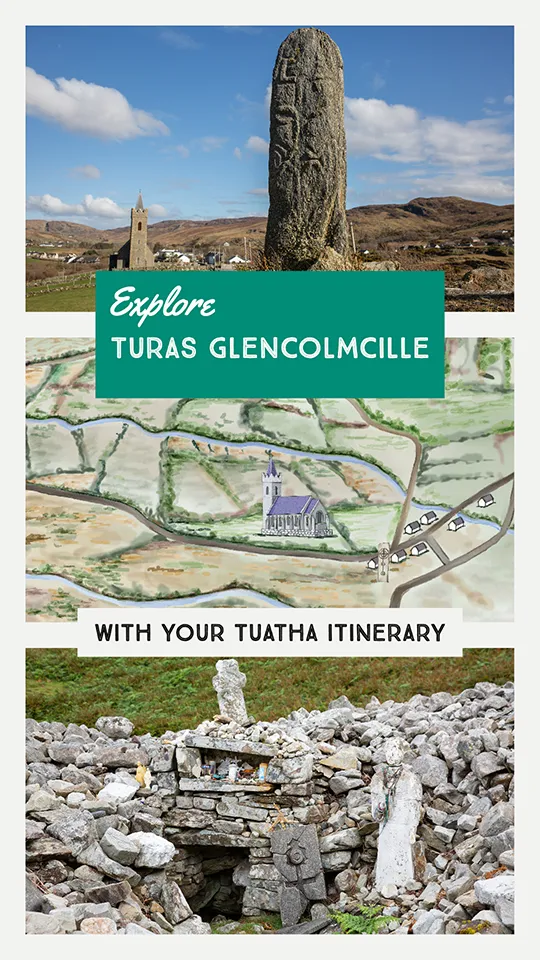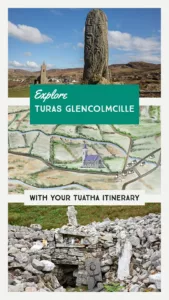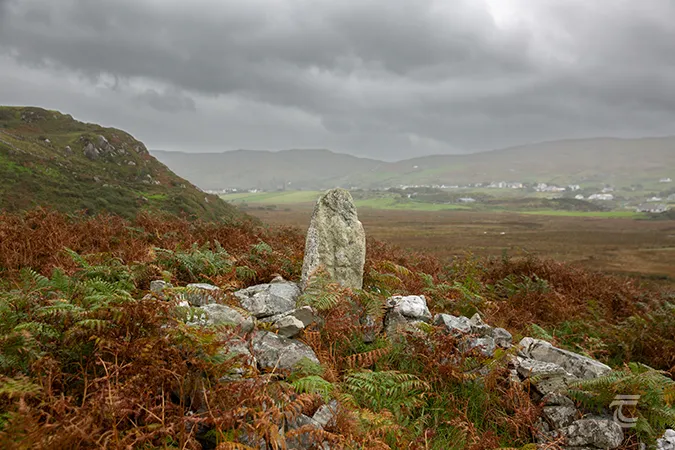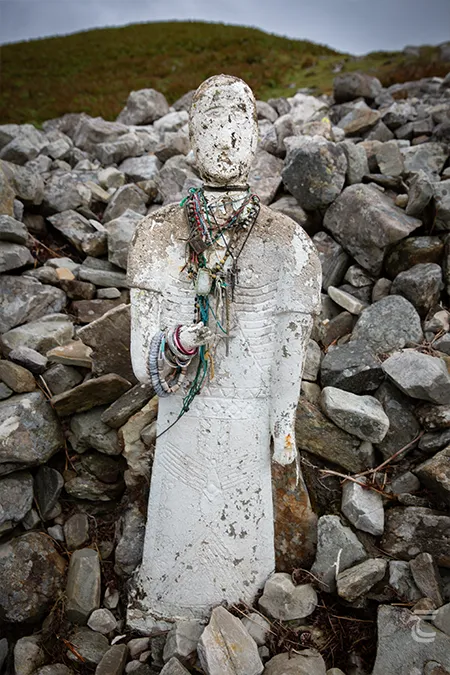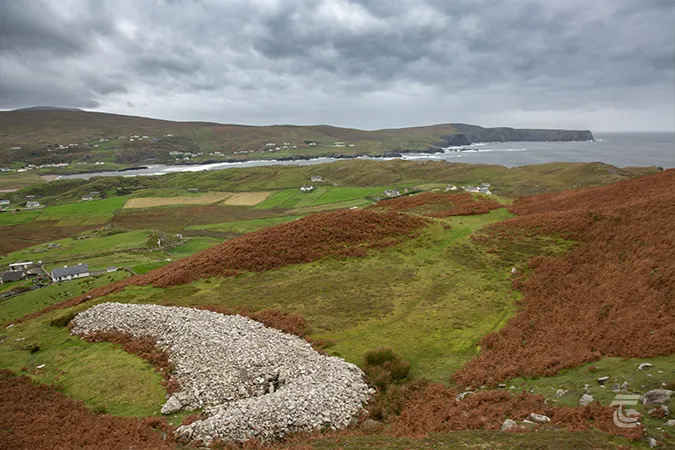Glencolmcille
A true wealth of heritage can be discovered in the scenic valley of Glencolmcille that shelters underneath Glen Head in the westernmost reaches of County Donegal. The valley takes its name from the early Irish saint, Colmcille. Also known as Saint Columba in the Latin form of his name, Colmcille was born in Donegal in either AD 520 or 521. Before his death in Iona on the 9th June AD 593, Colmcille had become one of the most influential figures in Irish and British history. He is one of Ireland’s patron saints, a distinction he shares with Patrick and Brigid, and he is the patron saint of Derry. Colmcille is not only an important figure for Ireland, but as the founder of monasteries in Iona and Scotland, he was a key catalyst for the spread of Christianity in Northern Britain.
The link between Glencolmcille and the saint derives from Manus O’Donnell’s 16th century work, Life of Colum Cille. A Turas or pilgrimage is held here every year, beginning on Colmcille’s Feast Day on the 9th June, where pilgrims visit each of the fifteen penitential stations that are set out along the valley. These penitential stations are quite varied: some have beautifully carved cross-inscribed slabs, while others are simple cairns and there’s even a holy well. The first station is a modified megalithic tomb, its appropriation into a Christian pilgrimage providing a fascinating blend of ancient belief and sacred spaces with Christianity. Indeed this beautiful valley abounds with prehistoric tombs, showing that people have been attracted to its unique tranquility and beauty for millennia, and that this valley was considered to be sacred long before Christianity reached these shores. There are two locations that are strong possibilities for the site of the original early monastic complex – the area known as Colmcille’s Chapel (see below), or on the site of the 19th century Church of Ireland church. Not only is this the point of both the start and end of the Turas, but you can also find a large souterrain complex underneath the hatch in the graveyard. During a project to celebrate Colmcille’s 1,500th birthday with Donegal County Council in 2018, we had the opportunity to descend into the dark of the souterrain. A truly memorable experience!
Today Glencolmcille is a small town of around 200 residents. It is a Gaeltacht (Irish speaking) area, and every year students of all ages come to Glencolmcille to study Irish and cultural courses with Oideas Gael. There are few better places to be immersed in Irish heritage than this scenic and historic landscape!
For practical information about visiting this site Click Here
A true wealth of heritage can be discovered in the scenic valley of Glencolmcille that shelters underneath Glen Head in the westernmost reaches of County Donegal. The valley takes its name from the early Irish saint, Colmcille. Also known as Saint Columba in the Latin form of his name, Colmcille was born in Donegal in either AD 520 or 521. Before his death in Iona on the 9th June AD 593, Colmcille had become one of the most influential figures in Irish and British history. He is one of Ireland’s patron saints, a distinction he shares with Patrick and Brigid, and he is the patron saint of Derry. Colmcille is not only an important figure for Ireland, but as the founder of monasteries in Iona and Scotland, he was a key catalyst for the spread of Christianity in Northern Britain.
The link between Glencolmcille and the saint derives from Manus O’Donnell’s 16th century work, Life of Colum Cille. A Turas or pilgrimage is held here every year, beginning on Colmcille’s Feast Day on the 9th June, where pilgrims visit each of the fifteen penitential stations that are set out along the valley. These penitential stations are quite varied: some have beautifully carved cross-inscribed slabs, while others are simple cairns and there’s even a holy well. The first station is a modified megalithic tomb, its appropriation into a Christian pilgrimage providing a fascinating blend of ancient belief and sacred spaces with Christianity. Indeed this beautiful valley abounds with prehistoric tombs, showing that people have been attracted to its unique tranquility and beauty for millennia, and that this valley was considered to be sacred long before Christianity reached these shores. There are two locations that are strong possibilities for the site of the original early monastic complex – the area known as Colmcille’s Chapel (see below), or on the site of the 19th century Church of Ireland church. Not only is this the point of both the start and end of the Turas, but you can also find a large souterrain complex underneath the hatch in the graveyard. During a project to celebrate Colmcille’s 1,500th birthday with Donegal County Council in 2018, we had the opportunity to descend into the dark of the souterrain. A truly memorable experience!
Today Glencolmcille is a small town of around 200 residents. It is a Gaeltacht (Irish speaking) area, and every year students of all ages come to Glencolmcille to study Irish and cultural courses with Oideas Gael. There are few better places to be immersed in Irish heritage than this scenic and historic landscape!
For practical information about visiting this site Click Here
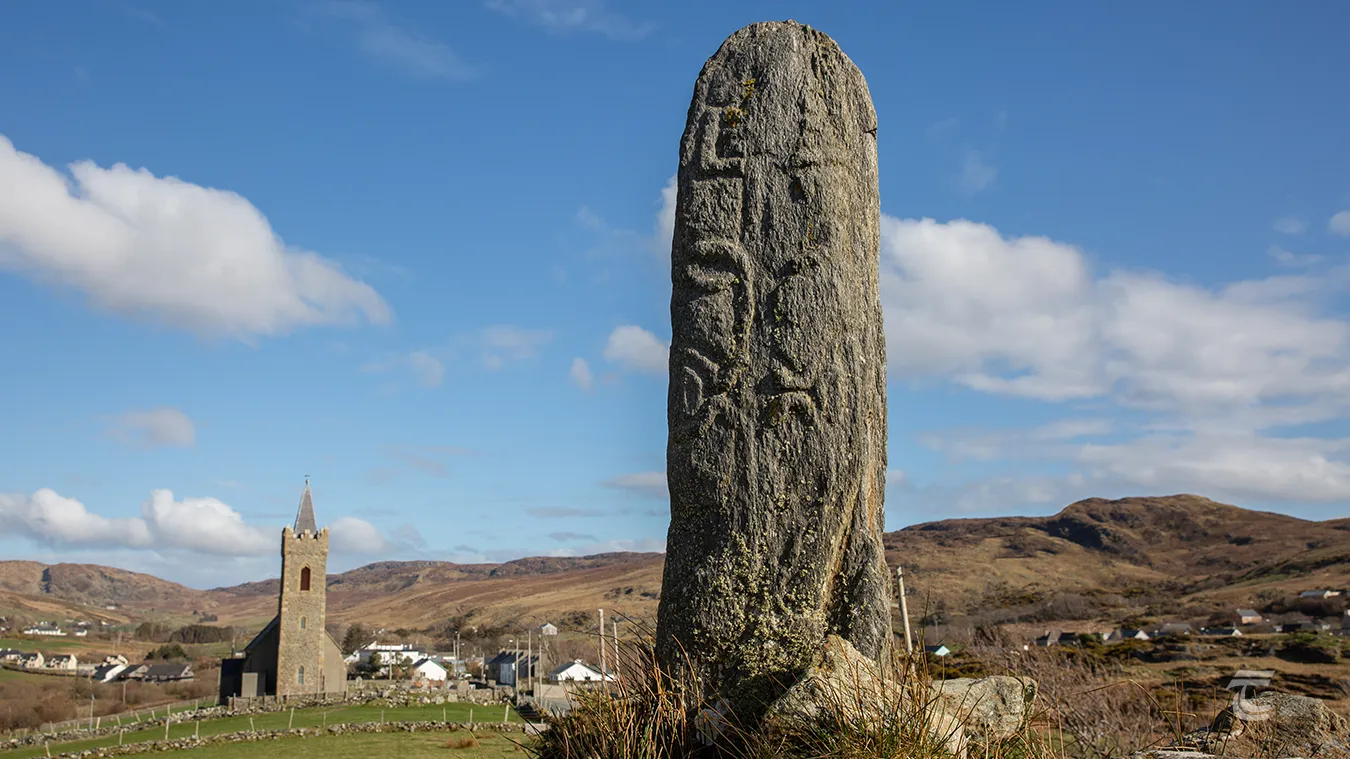
Station 2 Gallán Croise (Straid Cross Pillar) on the Turas Glencolmcille • Donegal
The Turas Glencolmcille
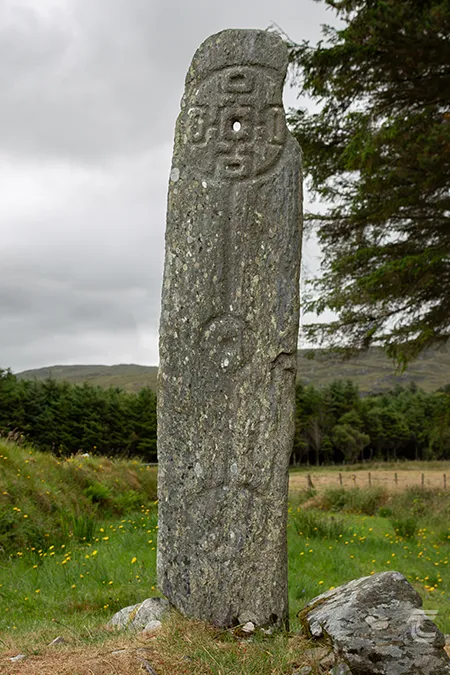
Cloch an Aonaigh (the Stone of the Gathering) on the Turas Glencolmcille • Donegal
The Turas Glencolmcille is one of the most rewarding historical and spiritual experiences that you can enjoy in Ireland. The blend of scenery with early medieval, and even Neolithic, heritage is truly wonderful. The pilgrim performs particular prescribed rituals at each of the fifteen stations as they make their way around the Turas. This normally consists of circling the station, while saying a number of prayers. A number of the stations have fascinating stories and folklore attached to them. Such as the Eighth Station, Cloch an Aonaigh – the Stone of the Gathering. This beautiful tall cross pillar has a small hole through the centre of the cross head. According to folklore, if you look through the hole you can catch a glimpse of paradise. However, a local in 1936 said that the visions of heaven had gone away because “the people are no longer what they used to be, and the class that’s going around now don’t deserve to see such sights.”
The Second Station is perhaps the most instantly recognisable, as it stands near to the 19th century Church of Ireland church. It has even featured in the epic animation Song of the Sea by Cartoon Saloon. A substantial complex of features can be found around Station Five – where you can find the remains of a small drystone church known as Séipeal Cholm Cille, or Colmcille’s Chapel. According to tradition, this was where Colmcille prayed and worked on manuscripts. From its size and appearance it is perhaps more likely that the structure represents a small chapel that may have once housed relics associated with the saint. Within the building you can see a flagstone that seals a cist-type feature. This is known as Leaba Cholmcille – ‘the Bed of Colmcille’. Three drystone cairns or leachtanna stand outside the chapel. Each one is surmounted by a cross-slab.
One of the most visually striking is Tobar Cholm Cille, St Colmcille’s Holy Well, set high on the hills above the valley. It consists of L-shaped penitential cairn that surrounds a small well. A small folk-art statue of Colmcille, possibly from the 1950s, stands near to the well and is often adorned by rosary beads and offerings left by pilgrims. With its spectacular views and undeniable sense of history, this is one of the most rewarding highlights of the whole Turas.

Cloch an Aonaigh (the Stone of the Gathering) on the Turas Glencolmcille • Donegal
The Twelfth Station is another stone with a big story. It is situated in Baile na nDeamhan – the Village of the Demons. According to Manus O’Donnell, long ago, this valley was haunted by demons, the very same evil spirits that St Patrick had driven out of Croagh Patrick in County Mayo. The demons cloaked the valley in a thick mist and turned the river into a fiery stream that no-one could cross, even to try meant certain death. Angels informed Colmcille of this, so he gathered a band of saints to cleanse the valley. They established a camp beside the fiery stream, when all of sudden a spear flew out of the mist and killed Colmcille’s servant. That angered the saint, he seized the same spear and hurled it back across the stream. As the spear travelled towards the mist the land was yielded to him, for the mist fled before the power of Colmcille’s cast. After that Colmcille blessed the stream and its venom and magic fire left it, allowing the saint and his retinue to cross. An angel brought him a round green stone and told him to throw it at the demons so that they and the mist would flee before it. The angel also told him to throw his own bell, the Dub Duaibsech, at them. Colmcille did as the angel commanded and he was victorious. The demons escaped to a rock out in the sea opposite the western headland of the Valley. Colmcille followed, and ordered the demons to go into the sea, and to transform into the form of fish forever. In the fear that anyone would eat them and be poisoned, Colmcille left a sign on them, marking them as different from any other fish, turning them red and blind in one eye. According to Manus O’Donnell, fishermen still caught such fish in his day, but recognising them from the old story, they immediately threw them back into the sea again. Following his victory, Colmcille blessed the land and made it a sanctuary. Today Glencolmcille remains a blessed place in every sense of the word. We have a detailed map guide to the Turas Glencolmcille and all its stations available for Tuatha Members.
Upper left: Station 7, Garraí Cholmcille (Colmcille’s Garden) • Lower left: Station 6, Tobar Cholm Cille (Colmcille’s Well) • Right: folk-art statue of Colmcille at Station 6
Top: Station 7, Garraí Cholmcille (Colmcille’s Garden) • Middle: folk-art statue of Colmcille at Station 6 • Bottom: Station 6, Tobar Cholm Cille (Colmcille’s Well)
